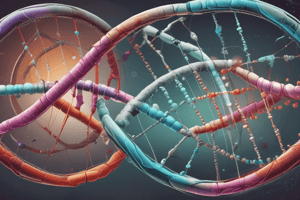Podcast
Questions and Answers
What is the primary focus of molecular biology?
What is the primary focus of molecular biology?
- The study of cellular behaviors
- The study of ecological systems
- The study of cellular structures
- The study of the structure, function, and interactions of biological molecules (correct)
What is the term for the flow of genetic information from DNA to proteins?
What is the term for the flow of genetic information from DNA to proteins?
- Molecular interactions
- Central Dogma (correct)
- Gene regulation
- Protein synthesis
What is the purpose of transcription?
What is the purpose of transcription?
- To synthesize proteins
- To create a complementary RNA copy from a DNA template (correct)
- To regulate gene expression
- To replicate DNA
What is the term for the bonding of nitrogenous bases in DNA?
What is the term for the bonding of nitrogenous bases in DNA?
What is the level of protein structure that refers to the sequence of amino acids?
What is the level of protein structure that refers to the sequence of amino acids?
What is the purpose of PCR?
What is the purpose of PCR?
What is the term for the process of synthesizing a protein from an mRNA template?
What is the term for the process of synthesizing a protein from an mRNA template?
What is the term for the arrangement of multiple polypeptide chains in a protein?
What is the term for the arrangement of multiple polypeptide chains in a protein?
Flashcards are hidden until you start studying
Study Notes
Key Concepts
- Molecular biology: the study of the structure, function, and interactions of biological molecules, such as DNA, RNA, proteins, and membranes.
- Central Dogma: the flow of genetic information from DNA to proteins, involving transcription and translation.
DNA Structure
- Double helix: the twisted ladder-like structure of DNA, composed of two complementary strands.
- Nucleotides: the building blocks of DNA, consisting of a sugar molecule, a phosphate group, and a nitrogenous base (A, C, G, or T).
- Base pairing: the complementary pairing of nitrogenous bases, with A-T and G-C being the two possible pairs.
Gene Expression
- Transcription: the process of creating a complementary RNA copy from a DNA template.
- Initiation: the binding of RNA polymerase to the promoter region.
- Elongation: the synthesis of RNA from the template DNA strand.
- Termination: the release of the RNA transcript.
- Translation: the process of synthesizing a protein from an mRNA template.
- Initiation: the binding of ribosomes to the mRNA.
- Elongation: the addition of amino acids to the growing protein chain.
- Termination: the release of the completed protein.
Proteins
- Primary structure: the sequence of amino acids in a protein.
- Secondary structure: the localized folding patterns of a protein, such as alpha helices and beta sheets.
- Tertiary structure: the overall 3D shape of a protein.
- Quaternary structure: the arrangement of multiple polypeptide chains in a protein.
Molecular Biology Techniques
- PCR (Polymerase Chain Reaction): a method for amplifying specific DNA sequences.
- Gel electrophoresis: a technique for separating and analyzing DNA or protein molecules based on size and charge.
- Western blot: a method for detecting specific proteins in a sample.
- Microarrays: a tool for analyzing the expression of thousands of genes simultaneously.
Applications of Molecular Biology
- Genetic engineering: the manipulation of an organism's genome to introduce new traits.
- Gene therapy: the use of genes to treat or prevent diseases.
- Forensic analysis: the use of DNA analysis in forensic science.
- Cancer research: the study of genetic changes associated with cancer development and progression.
Molecular Biology
- Molecular biology is the study of the structure, function, and interactions of biological molecules, such as DNA, RNA, proteins, and membranes.
DNA Structure
- The double helix is the twisted ladder-like structure of DNA, composed of two complementary strands.
- Nucleotides are the building blocks of DNA, consisting of a sugar molecule, a phosphate group, and a nitrogenous base (A, C, G, or T).
- Base pairing is the complementary pairing of nitrogenous bases, with A-T and G-C being the two possible pairs.
Gene Expression
- The Central Dogma is the flow of genetic information from DNA to proteins, involving transcription and translation.
- Transcription is the process of creating a complementary RNA copy from a DNA template, involving initiation, elongation, and termination.
- Translation is the process of synthesizing a protein from an mRNA template, involving initiation, elongation, and termination.
Proteins
- The primary structure of a protein is the sequence of amino acids.
- The secondary structure of a protein refers to localized folding patterns, such as alpha helices and beta sheets.
- The tertiary structure of a protein is the overall 3D shape.
- The quaternary structure of a protein refers to the arrangement of multiple polypeptide chains.
Molecular Biology Techniques
- PCR (Polymerase Chain Reaction) is a method for amplifying specific DNA sequences.
- Gel electrophoresis is a technique for separating and analyzing DNA or protein molecules based on size and charge.
- Western blot is a method for detecting specific proteins in a sample.
- Microarrays are a tool for analyzing the expression of thousands of genes simultaneously.
Applications of Molecular Biology
- Genetic engineering is the manipulation of an organism's genome to introduce new traits.
- Gene therapy is the use of genes to treat or prevent diseases.
- Forensic analysis is the use of DNA analysis in forensic science.
- Cancer research involves the study of genetic changes associated with cancer development and progression.
Studying That Suits You
Use AI to generate personalized quizzes and flashcards to suit your learning preferences.




